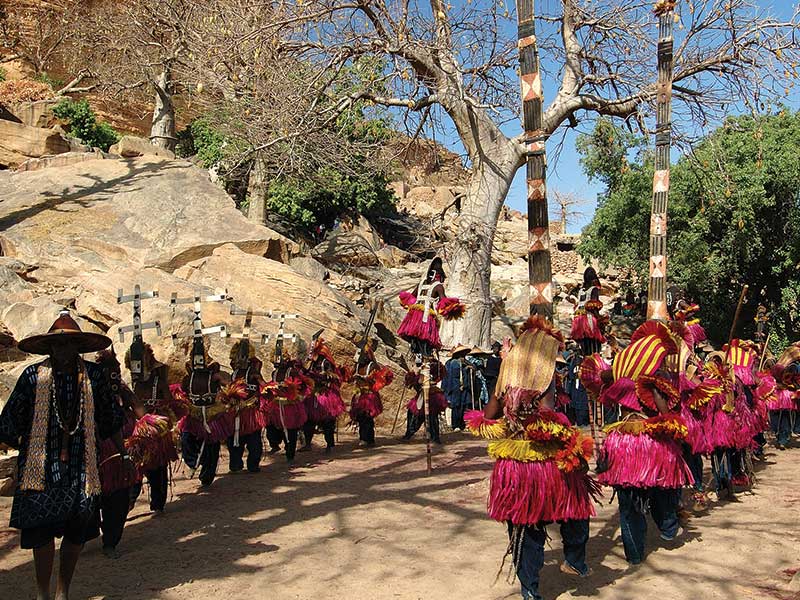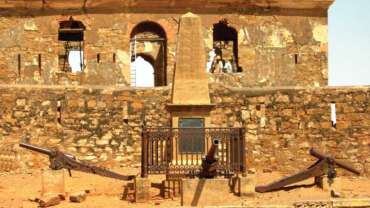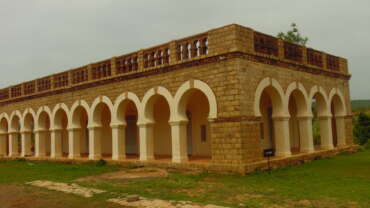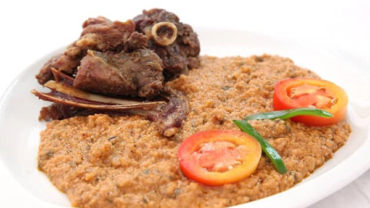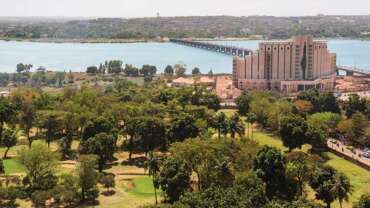Experiences in Mali
Gouina Falls
The Gouina Falls are located on the Senegal River, 80 km from Kayes on the road to Bafoulabé. The river, 400 m wide at this point, falls from a height of about 25 m.
An exceptional natural site, it gives a superb view of the current of water flowing into the river basin. The site abounds in a very rich flora and fauna including hippos, antelopes, monkeys, birds.
The elephants of Gourma
The space called Gourma in Mali concerns three regions (Mopti, Timbuktu and Gao). The area covers approximately 83,000 km², in eastern Mali, between the Niger River and the border with Burkina Faso. The Gourma is limited to the north and east by the Niger river, to the west and south by the hills and cliffs of the Dogon country. The Gourma is a vast area that covers large rock formations, dunes, plains, ponds, lakes and elephants.
The Gourma elephant biodiversity reserve is classified among semi-arid and arid zones. Flora and fauna had to adapt to these harsh conditions, including the relict population of 350 elephants. It is the only place in the Sahel, where you can meet elephants. The annual migration of these enormous Gourma elephants follows the large pools of the area.
The Gourma elephant population is unique in Africa for three reasons: it is the most northerly population of the continent, it is in an exceptionally difficult arid environment.
Woroni Falls
Between mountains, fields, orchards and other cliffs, in a peaceful little village called Woroni, is located 65 km from Sikasso on the road to Côte d’Ivoire the Woroni falls.
The waters fall from a height of 20 to 25 m, flow over a bed of rocks and form pools like an impressive natural swimming pool at the foot of the rocks. There is a microclimate around and a pleasant view of the site.
Baoulé Loop National Park
The Baoulé Loop National Park is a vast protected area of nearly 800,000 ha, which stretches from Siby to Kita, to the edge of the Mauritanian border. It includes several ecosystems: gallery forests, palm groves, bamboo forests, lakes. The most beautiful species of African antelope are present in the area, giraffes have been reintroduced, monkeys and warthogs abound. The best season to observe this fauna is between February and June. Archeology enthusiasts will also find a few sites, to their liking, in the reserve.
True green lung of 17 hectares in the heart of Bamako on the road to Koulouba, the National Park of Mali welcomes you all week for your moments of leisure. Open every day of the week, it is a place to relax with family or friends.
The National Park of Mali is also:
– Sports areas;
– Play areas;
– A Botanical garden. The plants will no longer have any secrets for you thanks to the botanical garden, the awareness circuit will explain everything in detail about local areas, medicinal plants and their benefits;
– Catering areas.
Ramsar sites in Mali
Mali joined the Ramsar convention in 1987, and had registered 5 wetlands of international importance in 2020.
• Inner Niger Delta, 2004
• Lake Magui, 2013
• Lake Wegnia, 2013
• Sourou Valley, transboundary site with the Burkina Faso 2019
INTERIOR DELTA OF THE NIGER RIVER: A WONDERFUL FOR ECOTOURISM IN MALI
The Inner Delta of the Niger River (DIN) is a vast flood zone with an area varying between 30,000 and 40,000 km ² depending on the level of floods. This vast area, the second in Africa by its size after the Okovango Delta in Botswana, extends into Mali over the regions of Ségou, Mopti and Timbuktu. An original space, the DIN contains ecological values of great international importance and a very wide biodiversity in terms of aquatic fauna, terrestrial fauna, man, culture, breeding, aquatic habitat and terrestrial habitat.
Thanks to its ecological values, it is today, in its entirety, recognized as a RAMSAR site (International Convention of Wetlands).
– Lakes Debo and Walado-Débo;
– The villages of Akka, Gourao, Dentaga, Walado, Sendegué, Dogo, Dialloubé, Konza, Kouakourou etc;
– Water birds: pelicans, African cormorants, anhinga, herons (purple and bittern herons), egrets, storks, spoonbills, ibises, cranes, geese, ducks, lincoles, terns, raptors, passerines, birds of the savannah;
– Large herbivores: manatees, hippos;
– Savannah fauna: reptiles, green monkeys, striped-sided jackals, Nile monitor lizards, marsh mongooses;
– Fish: according to Daget in 1954 and according to Greenwood in 1976, more than 130 species of fish live in the DIN;
– Natural habitats and ecosystems: open water, sandy shallows, bourgoutières, flooded forests, cultivated rice fields, wild rice fields, rocks, sand banks, memphar ponds.
Farako Falls
Between mountains, fields, orchards and other cliffs, in a peaceful little village called Woroni, is located 65 km from Sikasso on the road to Côte d’Ivoire the Woroni falls.
The waters fall from a height of 20 to 25 m, flow over a bed of rocks and form pools like an impressive natural swimming pool at the foot of the rocks. There is a microclimate around and a pleasant view of the site.



